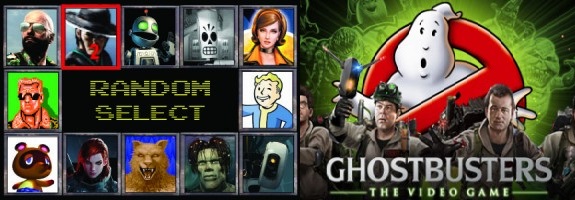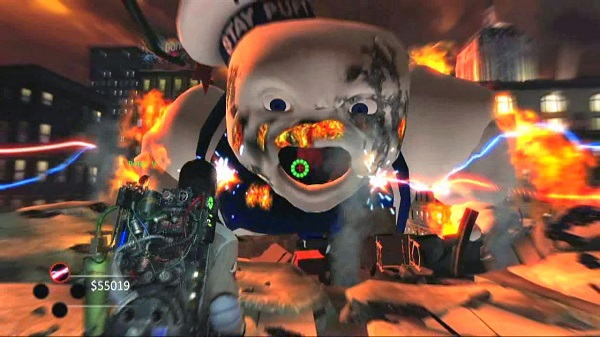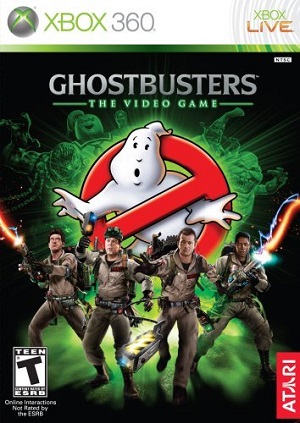 The Game: Ghostbusters: The Video Game
The Game: Ghostbusters: The Video Game
Developers: Terminal Reality/Threewave Software (Multiplayer)
Publisher: Infogrames/Atari
System: PC, PS3, Xbox 360
Buy It On Steam: HERE
Buy It On Amazon: HERE
The Premise: Two years after the events of Ghostbusters II, Venkman and co. take on a new recruit just in time for a new threat to emerge courtesy of the work of Ivo Shandor, the Gozer-worshipping architect who designed Dana’s apartment building in the first movie.
Is It Any Good?: It’s surprisingly okay, considering the number of developers making different versions of the game for different platforms (for the sake of simplicity, we’re focusing on the ‘lead’ version developed by Terminal Reality for PC, PS3 and 360) yet at the same time still manages to underachieve.
At least, it does the job of making ‘busting feel, ahem, good. The one thing a Ghostbusters game needs to get right gameplay-wise is to make the actual act of catching a ghost feel authentic, and Terminal Reality nail the lasso-like whip of the proton streams seen in the movies. They go off-book slightly by adding the need to switch to a ‘Capture Stream’ to coax spooks into the trap beam, but it feels appropriate enough to the movies’ tech to pass muster. It’s all very much ‘Gears of Buster’, but the slightly lumbering feel invited by the behind-the-shoulder perspective feels appropriate to the movies’ portrayal of the Ghostbusters as nerds and working schlubs rather than action heroes.
In fact, all of the technology feels ‘right’, with the PKE meter and goggles (Accessible via a first-person view) not only directing you to ghosts but also haunted artifacts that can be scanned for money and nuggets of lore. Most crucially, the act of lassoing a spook is just as much a wrestling contest as it looks on the silver screen, with hugely destructive proton steams flying all over the place. The game even tracks the cost of the damage you wreak throughout the game, with an achievement for the taking if you amass more than $3,000,000’s worth.
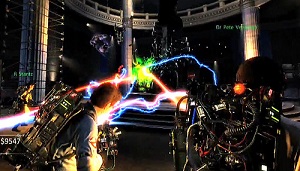 Taking a tip from the previous year’s Dead Space, UI elements such as health and weapon status are incorporated as visual elements on your proton pack, a nicely immersive touch that more games should employ. As the Rookie, you play alongside the original Ghostbusters as NPC companions, with a revive system making checkpoint restarts avoidable as long as at least one member of the team is standing. Unfortunately, the game suffers from the type of glitchy AI common to this type of mechanic, with the Busters getting constantly knocked down while slow to revive you. It becomes a problem when the game ramps up the difficulty, half the fight seeming to be against the suicidal AI of your companions than the actual ghosts.
Taking a tip from the previous year’s Dead Space, UI elements such as health and weapon status are incorporated as visual elements on your proton pack, a nicely immersive touch that more games should employ. As the Rookie, you play alongside the original Ghostbusters as NPC companions, with a revive system making checkpoint restarts avoidable as long as at least one member of the team is standing. Unfortunately, the game suffers from the type of glitchy AI common to this type of mechanic, with the Busters getting constantly knocked down while slow to revive you. It becomes a problem when the game ramps up the difficulty, half the fight seeming to be against the suicidal AI of your companions than the actual ghosts.
Where the system pays off is in the game’s surprisingly fun multiplayer. Teaming up with others for arena-based ghostbusting was an absolute blast, though it sadly never seemed to catch on and seemed to be pretty much dead after a few months. This may be because of the game’s muted reception, a real shame as it proved how well you could make ghost trapping work in a multiplayer environment (Seriously, no-one’s thought of a Ghostbusters Online based on this engine?).
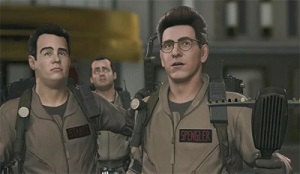 The story is where the game falters. It’s not necessarily bad, but much like Louis and Janine in Ghostbusters II, it’s kind of just there to tick boxes. Based on story ideas originally considered for Ghostbusters III (The first time they tried to make it) it mostly coasts on the use of Ivo Shandor as a link to the first movie, creating setpieces around the idea of him making more spook-channeling pieces of architecture but not developing anything narratively compelling from the idea. It’s all plot and very little story, hampered further by a script that simply isn’t very funny (despite the input of Dan Aykroyd and Harold Ramis) and somewhat lethargic voice performances from the cast. In-game dialogue is also annoyingly repetitive and poorly directed; I could happily live out my life without ever hearing Aykroyd awkwardly exclaiming “You ooowned that creep!” ever again.
The story is where the game falters. It’s not necessarily bad, but much like Louis and Janine in Ghostbusters II, it’s kind of just there to tick boxes. Based on story ideas originally considered for Ghostbusters III (The first time they tried to make it) it mostly coasts on the use of Ivo Shandor as a link to the first movie, creating setpieces around the idea of him making more spook-channeling pieces of architecture but not developing anything narratively compelling from the idea. It’s all plot and very little story, hampered further by a script that simply isn’t very funny (despite the input of Dan Aykroyd and Harold Ramis) and somewhat lethargic voice performances from the cast. In-game dialogue is also annoyingly repetitive and poorly directed; I could happily live out my life without ever hearing Aykroyd awkwardly exclaiming “You ooowned that creep!” ever again.
Ghostbusters: The Video Game is worth a play just for the feel of the ‘busting, but lazy writing and direction prevent it from being taken seriously as a ‘real’ installment of the franchise. It’s stuffed with production value and attention to detail (Make sure you click on the Vigo portrait in the fire house. A lot.) but it’s let down by creative laziness resulting in a great ghostbusting experience, but an underachieving Ghostbusters one.
Bonus Points: The game was originally developed for Activision, who dropped it when they merged with Blizzard in 2008. French publisher Infogrames quickly snapped the project up, announcing it for release under the Atari name.
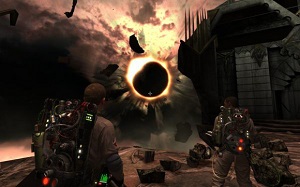 Sigourney Weaver initially declined to appear in the game, but later changed her mind to find that Dana Barrett had already been written out of the game and replaced with new character Dr. Ilyssa Selwyn (Played by Alyssa Milano). Rick Moranis’s non-involvement was chalked down to his semi-retirement from acting; though the Ghostbusters wiki quotes (alleged) unused pages from the game’s script in which Louis appears in a wheelchair due to alleged technical limitations preventing the developer from having a full body scan of Moranis. Unlike the Weaver situation, however, this has never been confirmed.
Sigourney Weaver initially declined to appear in the game, but later changed her mind to find that Dana Barrett had already been written out of the game and replaced with new character Dr. Ilyssa Selwyn (Played by Alyssa Milano). Rick Moranis’s non-involvement was chalked down to his semi-retirement from acting; though the Ghostbusters wiki quotes (alleged) unused pages from the game’s script in which Louis appears in a wheelchair due to alleged technical limitations preventing the developer from having a full body scan of Moranis. Unlike the Weaver situation, however, this has never been confirmed.
The Wii, PS2 and DS versions took on a more cartoony aesthetic rather than the realistic modelling of the PC, PS3 and 360 versions, with the DS game taking a completely different direction to the others and attracting comparisons to the classic 1984 David Crane Ghostbusters game.
This game us the first ever opportunity to hear Max von Sydow utter the phrase, “Pull my finger”. It’ll probably be the last, depending on how Episode VII pans out.
MOAR LIKE THIS PLZ: Ghostbusters (1984), Ghost Control, Inc., Ghostbusters: Sanctum of Slime
